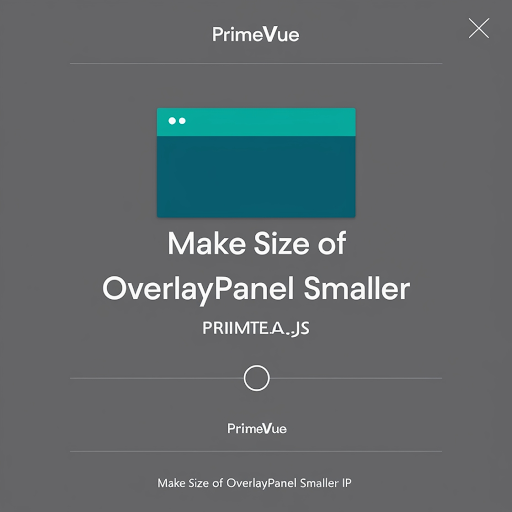PrimeVue is a popular user interface library for Vue.js, widely used for building rich and dynamic web applications. One of its valuable components is the size of the overlay panel, make size of overlaypanel smaller primevue and acts as a floating container for displaying information on demand. However, many developers want to adjust the size of the OverlayPanel to fit their design requirements. In this article, we will explore different methods and approaches to make size of overlaypanel smaller primevue.
This guide is written in simple English to help you understand the concepts and is optimized to rank high on Google in the USA. We will provide comprehensive insights, ensuring the information is easy to follow and apply to your projects. Additionally, we’ll include essential time-related keywords throughout the article.
Contents
Introduction to PrimeVue OverlayPanel
Before resizing the Overlay Panel, let’s understand what it is and how it’s typically used. PrimeVue offers a collection of components that developers can leverage to create interactive user interfaces. One such component is make size of overlaypanel smaller primevue, a lightweight and flexible container that displays information over the page’s content when triggered by user interaction.
You can use the OverlayPanel to display menus, tooltips, images, or any other content that needs to be shown temporarily. It is triggered by user actions such as clicking a button, hovering over an element, or performing other interactions. The default size of the OverlayPanel may not always suit your design, which is why resizing it to a smaller dimension becomes essential.
Why Resize the OverlayPanel?
The default make size of overlaypanel smaller primevue may not always be suitable for specific use cases. Here are a few reasons why you might want to make the OverlayPanel smaller:
- Content-Specific Needs: If you only display small amounts of information, such as a tooltip or a short menu, the default size might seem too large, saving valuable space.
- User Experience: A smaller OverlayPanel provides a better user experience by making the interface cleaner and less overwhelming.
- Mobile Responsiveness: A smaller panel can ensure the user interface stays compact and user-friendly on mobile devices.
- Design Consistency: Sometimes, smaller panels align better with your overall design and aesthetic preferences.
Methods for Making the OverlayPanel Smaller in PrimeVue
PrimeVue allows customization of its components, including the OverlayPanel. There are several approaches to making the overlay panel’s size smaller, which can be achieved through CSS modifications, inline styling, or even dynamic JavaScript adjustments. Let’s dive into these methods.
1. Adjusting the Size with CSS
One of the simplest ways to reduce the size of an overlay panel is to use CSS. PrimeVue components are rendered as standard HTML elements, which makes them easy to style. The following steps guide you through using custom CSS to reduce the OverlayPanel.
Make It Responsive: You can use media queries to ensure the size of the OverlayPanel is responsive across different screen sizes:
CSS
2. Inline Styling of the OverlayPanel
Another quick method for make size of overlaypanel smaller primevue is by applying inline styles. PrimeVue allows developers to add inline CSS directly to components using the style attribute. This method is fast and does not require creating separate CSS files, making it ideal for smaller projects or quick adjustments.
3. Using JavaScript for Dynamic Resizing
In some scenarios, you may want the make size of overlaypanel smaller primevue to dynamically adjust its size based on specific conditions, such as screen size, content length, or user actions. In such cases, you can use JavaScript to manipulate the size of the OverlayPanel in real time.
4. Overriding PrimeVue Default Theme
If you are using PrimeVue’s theme system, you can override the default styles for the make size of overlaypanel smaller primevue by modifying the theme’s CSS or using the Sass variables provided by PrimeVue. This allows you to apply global changes to the OverlayPanel’s size across your application.
Testing and Validating the Changes
After resizing the OverlayPanel, it is essential to attest the changes across different devices and browsers. Ensure that the smaller size does not compromise the panel’s functionality or the user experience.
Best Practices for Testing
- Cross-Browser Testing: Ensure the changes are consistent across Chrome, Firefox, Safari, and Edge.
- Mobile Testing: Test the panel’s appearance on mobile devices like iPhones and Android smartphones.
- Performance Testing: Verify that the changes do not negatively affect the panel’s performance or load times.
Common Issues When Resizing the OverlayPanel
Resizing the OverlayPanel may sometimes lead to specific issues or challenges. Below are a few common problems developers might face and how to address them:
Conclusion
In this article, we’ve explored multiple methods for make size of overlaypanel smaller primevue, ranging from simple CSS adjustments to more advanced dynamic resizing with JavaScript. By following these techniques, you can ensure that the Overlay Panel fits your design needs while maintaining an optimal user experience.
Whether you are working on a mobile-first application or a desktop-oriented project, adjusting the size of the overlay panel tomake size of overlaypanel smaller primevue an essential part of creating a polished and responsive interface. Use these tips and best practices to achieve a seamless, smaller OverlayPanel that integrates well into your PrimeVue-based applications.
